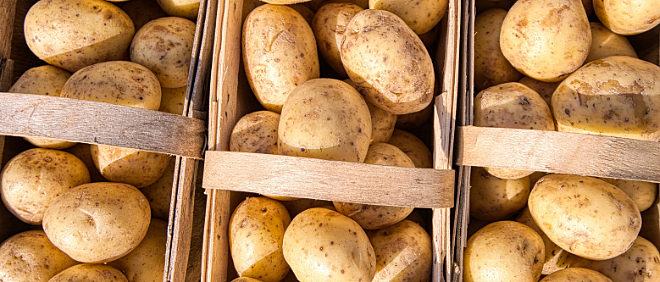Energy from wastewater in the potato & starch industry
Sustainable water management with anaerobic-aerobic treatment

Treating wastewater and potato waste
Potato processing requires large amounts of water. Raw potatoes need cleaning prior to processing. In addition, operations such as potato peeling, dicing or cutting cause the cells to release starch, which is often rinsed-off using fresh water resulting in large quantities of starch-loaded wastewater.
Our portfolio includes smart solutions for the treatment of potato processing wastewater as well as the valorization of potato peels and spills. Depending on organic pollution concentration, a dedicated digestion reactor is selected for optimal water treatment and biogas yield.

Wastewater treatment
In most cases, the concentration of organic pollution in potato processing wastewater ranges from 5 up to 20 kg COD/m³. Depending on the available plot size, two treatment options are to be considered.
- With more than 25 BIOTIM® UASB reactors in de potato industry, the proven technology offers a robust solution offering the highest removal efficiency and biogas production for less concentrated wastewaters.
- For smaller plot-sizes and higher concentrated wastewater containing up to 25kg COD/m³, the BIOTIM® High Rate Anaerobic Tower enables similar efficiencies in taller reactors requiring half the plot size.
Potato waste valorisation
High-capacity potato processing comes with large volumes of concentrated potato waste like starch-loaded wastewater, potato peels or waste oils. The organic load varies from 160 kg COD/m³ for potato peels, up to 500 kg COD/m³ for French fries. The biogas and energy potential increases accordingly.
Depending on the bio-waste characteristics, the BIOTIM® UAC or BIOTIM® CSTR reactors will help reducing the organic pollution while recovering a maximum of energy. Unfolding the energy potential of waste helps cutting down on the energy supply needed from the grid.
A potato processing factory can produce up to 10% of its thermal energy needs out of the wastewater only
Reducing the eco footprint
Large potato processors combine 2 dedicated reactors to digest up to 90 % of the total organic pollution. Both reactors are designed for maximum biogas yield.
The effluent from the reactor treating the wastewater will be further treated in a LUCAS® aerobic post-treatment for compliance with discharge regulations. The digested sludge from potato waste can be recovered as soil conditioner for agriculture after dewatering.
ASSISTING potato processing & starch industry in wastewater treatment

Redesigning and operating an out-of-use wastewater treatment facility
Waterleau redesigned and transformed the out-of-service and original wastewater treatment plant to comply with regulatory discharge regulations.

Ecofrost's Sustainable Energy Transition with Waterleau's BIOTIM® Scrubber
FAQ
What is potato & starch waste?
Potato and starch waste typically refers to the byproducts and residues generated during the processing and manufacturing of potato-based products and starch-derived items. In industries like those involving potatoes (e.g., for making potato chips, fries, and other potato-based foods) and starch production (often from sources like corn, wheat, potatoes, and other grains), waste is an inevitable part of the process.
This waste can include:
- Solid Waste: Peelings, pulp, and other potato residues that are left after the potatoes are cleaned, peeled, and processed.
- Liquid Waste: Wastewater containing organic matter, starch, and other dissolved solids. This is generated during the washing, peeling, and processing stages.
- Sludge: This is a semi-solid waste that settles out from the wastewater treatment processes.
Potato and starch waste, if not managed properly, can have a significant environmental impact. This is due to the high organic content which can lead to issues like water pollution and greenhouse gas emissions if the waste is not treated or disposed of properly.
However, with the right technologies and approaches, this waste can be managed sustainably. It can be used for various beneficial purposes like biogas production, animal feed, composting, and as a raw material for the production of bio-plastics and other bio-based products.
Find your local contact
Our expertise is always within reach. Digital communication has cut long distances short, but we advocate the traditional way of sharing insights.
Contact us today. We are looking forward to help you reach your sustainable development goals.




